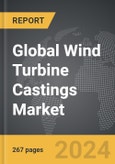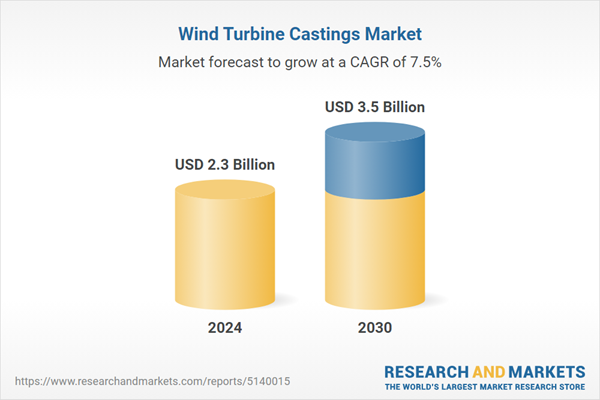Global Wind Turbine Castings Market - Key Trends and Drivers Summarized
What Are the Key Differences Between Horizontal and Vertical Axis Wind Turbine Castings?
Wind turbine castings are integral to the structural and operational efficiency of wind energy systems, with two primary types distinguished by their axis orientation: horizontal axis wind turbine (HAWT) castings and vertical axis wind turbine (VAWT) castings. HAWT castings dominate the market due to their superior efficiency, scalability, and higher energy output. These turbines typically incorporate cast components such as nacelles, rotor hubs, gearboxes, and blades, all designed to endure extreme mechanical stress and environmental conditions. Their aerodynamic structure allows for efficient wind capture, making them the preferred choice for large-scale wind farms. On the other hand, VAWT castings, though less common, serve specialized applications where space constraints or turbulent wind conditions necessitate their use. These castings allow for a compact design, offering flexibility in urban settings and low-wind regions. The resurgence of VAWTs is driven by recent advancements in blade design and materials, improving their efficiency and making them viable for distributed wind power systems. As the industry continues evolving, manufacturers are refining both HAWT and VAWT castings to enhance durability, reduce material costs, and improve energy conversion rates.How Does Turbine Size Influence the Casting Market?
The wind turbine casting market is segmented based on turbine size, classified into small, medium, and large turbines. Small turbines, with a capacity of less than 10 MW, cater primarily to residential, commercial, and off-grid applications. The cast components used in these turbines prioritize lightweight materials and modular designs for easier deployment and cost efficiency. Medium turbines, ranging from 10 MW to 19 MW, are widely deployed in utility-scale projects and distributed energy systems. Their castings require greater durability, incorporating high-strength materials to support increased mechanical loads while maintaining efficiency. Large turbines, exceeding 20 MW, are predominantly used in offshore wind farms and high-capacity onshore installations. The castings for these turbines are engineered to withstand extreme weather conditions, high wind speeds, and prolonged exposure to marine environments. As the demand for higher capacity turbines grows, manufacturers are investing in advanced casting techniques, including precision molding and alloy enhancements, to improve the strength-to-weight ratio and extend operational lifespans. This segmentation reflects the increasing push toward larger turbines, driven by the need for higher efficiency and economies of scale in energy generation.Which Materials Are Leading the Evolution of Wind Turbine Castings?
Material selection plays a crucial role in the performance and longevity of wind turbine castings, with steel, iron, aluminum alloys, glass-reinforced plastic (GRP), and copper being the most widely used materials. Steel remains the predominant choice due to its high tensile strength, corrosion resistance, and cost-effectiveness, making it ideal for turbine towers, nacelles, and rotor hubs. Cast iron, particularly ductile iron, is extensively utilized for components such as gearbox housings and mainframes due to its durability and shock absorption properties. Aluminum alloys are gaining traction for applications requiring lightweight yet strong components, particularly in offshore wind turbines where weight reduction is critical. Glass-reinforced plastic is revolutionizing the wind energy sector by enabling the production of longer, aerodynamically optimized blades that enhance energy capture while minimizing structural weight. Copper, though used in smaller quantities, is essential for electrical conductivity in generator windings and control systems. The ongoing innovations in composite materials and advanced alloys are expected to further refine wind turbine castings, reducing maintenance needs and enhancing energy efficiency. As manufacturers explore high-performance materials, the shift toward hybrid composites and corrosion-resistant coatings is shaping the future of wind turbine construction.What Factors Are Driving the Growth in the Wind Turbine Castings Market?
The growth in the wind turbine castings market is driven by several factors, including rapid advancements in wind energy technology, increasing investments in renewable power projects, and the growing preference for offshore wind installations. The transition to larger wind turbines is a significant driver, as high-capacity turbines require robust, precision-engineered castings capable of withstanding extreme mechanical stress. The rising adoption of offshore wind farms, particularly in regions with strong and consistent wind patterns, is fueling demand for corrosion-resistant castings that can endure harsh marine environments. Additionally, policy incentives and government mandates supporting renewable energy expansion are encouraging greater deployment of wind power, leading to higher demand for specialized turbine components. The push for cost reduction in wind energy production has led manufacturers to invest in automated casting processes, 3D printing, and advanced metallurgical techniques to enhance efficiency while reducing material waste. Furthermore, the integration of smart sensors and digital twin technology in turbine design is influencing casting innovations, enabling predictive maintenance and extending component lifespans. With increasing global commitments to reducing carbon emissions and achieving energy sustainability, the demand for high-performance wind turbine castings is expected to witness sustained growth, reinforcing its role in the future of clean energy generation.Report Scope
The report analyzes the Wind Turbine Castings market, presented in terms of market value (USD). The analysis covers the key segments and geographic regions outlined below.- Segments: Type (Horizontal Axis Castings, Vertical Axis Castings); Application (On-Shore Application, Off-Shore Application).
- Geographic Regions/Countries: World; USA; Canada; Japan; China; Europe; France; Germany; Italy; UK; Spain; Russia; Rest of Europe; Asia-Pacific; Australia; India; South Korea; Rest of Asia-Pacific; Latin America; Argentina; Brazil; Mexico; Rest of Latin America; Middle East; Iran; Israel; Saudi Arabia; UAE; Rest of Middle East; Africa.
Key Insights:
- Market Growth: Understand the significant growth trajectory of the Horizontal Axis Castings segment, which is expected to reach US$3.2 Billion by 2030 with a CAGR of 7.4%. The Vertical Axis Castings segment is also set to grow at 9.3% CAGR over the analysis period.
- Regional Analysis: Gain insights into the U.S. market, valued at $342.4 Million in 2024, and China, forecasted to grow at an impressive 9.3% CAGR to reach $662.3 Million by 2030. Discover growth trends in other key regions, including Japan, Canada, Germany, and the Asia-Pacific.
Why You Should Buy This Report:
- Detailed Market Analysis: Access a thorough analysis of the Global Wind Turbine Castings Market, covering all major geographic regions and market segments.
- Competitive Insights: Get an overview of the competitive landscape, including the market presence of major players across different geographies.
- Future Trends and Drivers: Understand the key trends and drivers shaping the future of the Global Wind Turbine Castings Market.
- Actionable Insights: Benefit from actionable insights that can help you identify new revenue opportunities and make strategic business decisions.
Key Questions Answered:
- How is the Global Wind Turbine Castings Market expected to evolve by 2030?
- What are the main drivers and restraints affecting the market?
- Which market segments will grow the most over the forecast period?
- How will market shares for different regions and segments change by 2030?
- Who are the leading players in the market, and what are their prospects?
Report Features:
- Comprehensive Market Data: Independent analysis of annual sales and market forecasts in US$ Million from 2024 to 2030.
- In-Depth Regional Analysis: Detailed insights into key markets, including the U.S., China, Japan, Canada, Europe, Asia-Pacific, Latin America, Middle East, and Africa.
- Company Profiles: Coverage of players such as ABB Ltd., Aeolos Wind Energy Ltd, AEROVIDE GmbH, API Engineering Ltd, ASK Chemicals GmbH and more.
- Complimentary Updates: Receive free report updates for one year to keep you informed of the latest market developments.
Some of the 36 companies featured in this Wind Turbine Castings market report include:
- ABB Ltd.
- Aeolos Wind Energy Ltd
- AEROVIDE GmbH
- API Engineering Ltd
- ASK Chemicals GmbH
- Baettr Lem
- Besfond Srl
- Bronze Craft Corporation
- Cheng Feng Casting Factory Co., Ltd.
- Combitherm A/S
This edition integrates the latest global trade and economic shifts into comprehensive market analysis. Key updates include:
- Tariff and Trade Impact: Insights into global tariff negotiations across 180+ countries, with analysis of supply chain turbulence, sourcing disruptions, and geographic realignment. Special focus on 2025 as a pivotal year for trade tensions, including updated perspectives on the Trump-era tariffs.
- Adjusted Forecasts and Analytics: Revised global and regional market forecasts through 2030, incorporating tariff effects, economic uncertainty, and structural changes in globalization. Includes historical analysis from 2015 to 2023.
- Strategic Market Dynamics: Evaluation of revised market prospects, regional outlooks, and key economic indicators such as population and urbanization trends.
- Innovation & Technology Trends: Latest developments in product and process innovation, emerging technologies, and key industry drivers shaping the competitive landscape.
- Competitive Intelligence: Updated global market share estimates for 2025, competitive positioning of major players (Strong/Active/Niche/Trivial), and refined focus on leading global brands and core players.
- Expert Insight & Commentary: Strategic analysis from economists, trade experts, and domain specialists to contextualize market shifts and identify emerging opportunities.
Table of Contents
Companies Mentioned (Partial List)
A selection of companies mentioned in this report includes, but is not limited to:
- ABB Ltd.
- Aeolos Wind Energy Ltd
- AEROVIDE GmbH
- API Engineering Ltd
- ASK Chemicals GmbH
- Baettr Lem
- Besfond Srl
- Bronze Craft Corporation
- Cheng Feng Casting Factory Co., Ltd.
- Combitherm A/S
Table Information
| Report Attribute | Details |
|---|---|
| No. of Pages | 288 |
| Published | December 2025 |
| Forecast Period | 2024 - 2030 |
| Estimated Market Value ( USD | $ 2.3 Billion |
| Forecasted Market Value ( USD | $ 3.5 Billion |
| Compound Annual Growth Rate | 7.5% |
| Regions Covered | Global |









